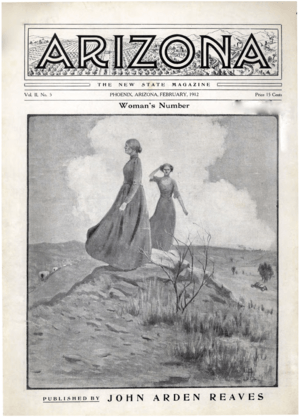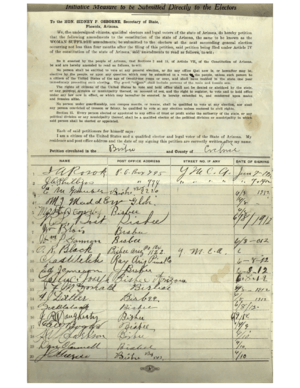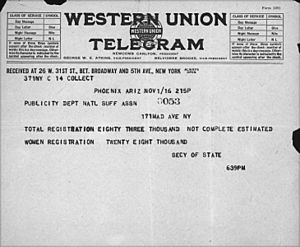Timeline of women's suffrage in Arizona facts for kids
This is a timeline showing how women in Arizona gained the right to vote. The journey started long ago, with many people working hard to make it happen. Women's suffrage means women having the right to vote in elections.
The first bill to allow women to vote was introduced in Arizona in 1883, but it didn't pass. People who supported women's voting rights, called suffragists, kept trying. They worked to influence lawmakers and formed groups to push for change.
In 1897, women who paid taxes were allowed to vote in school board elections. This was a small step forward. More bills were introduced, and one even passed in 1903, but the governor stopped it.
When Arizona became a state in 1912, a new attempt to give women the right to vote failed. But then, a woman named Frances Munds led a successful campaign. On November 5, 1912, Arizona voters decided that women should have the right to vote!
In 1913, women could officially sign up to vote. They participated in their first primary elections in 1914. Arizona also approved the 19th Amendment to the U.S. Constitution in 1920, which gave women across the country the right to vote. However, some groups, like Native American women and Latinas, had to wait even longer to fully exercise their voting rights.
Contents
Early Efforts for Voting Rights
Starting in the 1880s
1883
- A bill was introduced to let women vote in school board elections, but it did not pass.
1884
- The first Arizona group of the Woman's Christian Temperance Union (WCTU) was formed. This group often supported women's voting rights.
1887
- The Arizona Woman's Equal Rights Association (AWERA) was started in Phoenix. This group worked for equal rights for women.
Progress in the 1890s
1891
- Josephine Brawley Hughes and Laura M. Johns spoke about women's voting rights at an important meeting called the Territorial Constitutional Convention.
- The idea of women voting failed at the convention by only three votes.
- Hughes helped start the Arizona Suffrage Association.
1895
- Laura M. Johns gave speeches in Phoenix, Tempe, and Tucson to support women's voting rights.
1896
- January: Josephine Brawley Hughes went to a big national meeting for women's suffrage in Washington, D.C.
1897
- Laura M. Johns spoke to the Arizona legislature about women's voting rights.
- A law was passed allowing women who paid taxes to vote in school board elections.
1899
- Carrie Chapman Catt, a famous leader for women's suffrage, visited Phoenix.
- A bill to give women full voting rights passed in the lower house of the legislature.
- However, the law that allowed taxpaying women to vote in school board elections was later declared invalid by the Arizona Supreme Court.
The Fight Continues in the 1900s
Early 1900s Challenges
1901
- Lida P. Robinson worked to promote a bill for women's voting rights, but it did not pass.
1902
- A meeting for women's suffrage was held in Phoenix.
1903
- Governor Alexander Oswald Brodie stopped the women's suffrage bill by using his veto power. This meant the bill did not become a law.
1905
- The movement for women's voting rights in Arizona slowed down. A national group sent Mary C. C. Bradford to help restart interest.
1909
- Laura Clay and Frances Munds spoke to the territorial legislature about women's voting rights, but the bill did not pass.
- The legislature passed a law requiring a literacy test for voting. This test made it harder for some people, especially Mexican Americans, to vote.
Winning the Vote in the 1910s
1910
- Laura Gregg from a national suffrage group came to Arizona to help organize more local groups.
- October 10: The Arizona Constitutional Convention met to write the state's new constitution.
- Suffragists tried to convince the delegates to include women's voting rights in the constitution, but they were not successful.
1912
- February 14: Arizona officially became a state!
- A bill to add women's voting rights to the Arizona Constitution failed by just one vote in the state legislature.
- Frances Munds started a campaign to collect signatures to put women's voting rights directly on the November ballot for voters to decide.
- July 5: Munds collected over 4,000 signatures, which was enough to get the women's suffrage idea on the ballot.
- October: Suffragists had a booth at the Arizona State Fair to tell people about women's voting rights.
- November 5: Voters approved women's equal voting rights, and it became part of the Arizona Constitution!
- Another literacy test law was passed, which further reduced the number of Mexican American voters.
1913
- January: The Arizona State Legislature held a special meeting and passed a law allowing women to register to vote.
- March 15: Women in Arizona were officially allowed to sign up to vote for all elections.
- May: A celebration parade was held in New York City for Arizona, Kansas, and Oregon because they had given women the right to vote. Madge Udall represented Arizona in the parade.
1914
- Women participated in their first primary elections in Arizona. Primary elections help choose which candidates will run in the main election.
- Organizers from the Congressional Union for Woman Suffrage, Josephine Casey and Jane Pincus, came to Arizona.
1916
- April 20: The "Suffrage Special" train, carrying suffragists, made a brief stop in Maricopa and then arrived in Tucson.
- April 21: The Suffrage Special train arrived in Phoenix.
Voting Rights for All Women
1920
- February 12: A special meeting of the Arizona legislature was held to approve the Nineteenth Amendment to the U.S. Constitution. It was approved the same day. This amendment gave women across the entire United States the right to vote.
1924
- Native Americans were granted United States Citizenship. However, many still faced challenges in voting.
1948
- The Arizona Supreme Court overturned the ban that prevented Native Americans from voting in Arizona.
1965
- The Voting Rights Act helped Latina voters and other minority groups in Arizona to fully exercise their right to vote without unfair barriers.
1970
- English literacy tests, which had been used to prevent some people from voting, were outlawed in Arizona.




